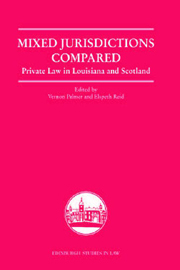Book contents
- Frontmatter
- Contents
- Preface
- List of Contributors
- List of Abbreviations
- Table of Cases
- 1 Praedial Servitudes
- 2 Title Conditions in Restraint of Trade
- 3 Servitudes: Extinction by Non-Use
- 4 Inheritance and the Surviving Spouse
- 5 Ownership of Trust Property in Scotland and Louisiana
- 6 The Legal Regulation of Adult Domestic Relationships
- 7 Impediments to Marriage in Scotland and Louisiana: An Historical-Comparative Investigation
- 8 Contracts of Intellectual Gratification – A Louisiana-Scotland Creation
- 9 The Effect of Unexpected Circumstances on Contracts in Scots and Louisiana Law
- 10 Hunting Promissory Estoppel
- 11 Unjustified Enrichment, Subsidiarity and Contract
- 12 Causation as an Element of Delict/Tort in Scots and Louisiana Law
- 13 Personality Rights: A Study in Difference
- Index
5 - Ownership of Trust Property in Scotland and Louisiana
Published online by Cambridge University Press: 12 September 2012
- Frontmatter
- Contents
- Preface
- List of Contributors
- List of Abbreviations
- Table of Cases
- 1 Praedial Servitudes
- 2 Title Conditions in Restraint of Trade
- 3 Servitudes: Extinction by Non-Use
- 4 Inheritance and the Surviving Spouse
- 5 Ownership of Trust Property in Scotland and Louisiana
- 6 The Legal Regulation of Adult Domestic Relationships
- 7 Impediments to Marriage in Scotland and Louisiana: An Historical-Comparative Investigation
- 8 Contracts of Intellectual Gratification – A Louisiana-Scotland Creation
- 9 The Effect of Unexpected Circumstances on Contracts in Scots and Louisiana Law
- 10 Hunting Promissory Estoppel
- 11 Unjustified Enrichment, Subsidiarity and Contract
- 12 Causation as an Element of Delict/Tort in Scots and Louisiana Law
- 13 Personality Rights: A Study in Difference
- Index
Summary
Trusts make those accustomed to Civilian property systems uncomfortable, given that they seem to rely on the peculiar Common Law separation of legal and equitable ownership. Equity, it seems, is a concept to be avoided at all costs. (This is not always true. The very first sentence of Mackenzie Stuart's book on the Scottish law of trusts explains that a trust is “nothing except a confidence reposed by one person in another, and enforceable in a Court of Equity”, but few if any Scottish writers would be comfortable making this sort of statement today.)
For that reason, one would expect both Scotland and Louisiana to have some difficulty with the trust. And those expectations would be met, although in very different ways. In Scotland, the law has followed practice: trusts exist, and questions of what they are and why they work have been seen as of secondary importance. Hence the Trusts (Scotland) Act 1921 laconically informs the reader that, for the purposes of the statute, the word “trust” includes “any trust”. The leading textbook on the subject includes a section headed “Definitions of trust”, which reviews five different possible definitions of a trust in order to inform the reader that they are all incorrect. The authors do then offer a definition of their own, and the present writer has kept up the tradition by arguing that this definition is itself defective.
- Type
- Chapter
- Information
- Mixed Jurisdictions ComparedPrivate Law in Louisiana and Scotland, pp. 132 - 145Publisher: Edinburgh University PressPrint publication year: 2009



